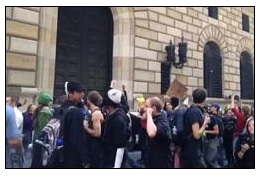
Occupy Wall Street Protesters Outside the New York Fed, September 17, 2012. The chant was: “Banks got bailed out, we got sold out.”
By Pam Martens and Russ Martens: March 19, 2020 ~
The Fed’s H.4.1 report was released at 4:30 p.m. today and it shows that the Federal Reserve’s balance sheet has skyrocketed to $4.7 trillion. It also shows that as of yesterday, its repo loans to the trading houses on Wall Street had soared to a total of $441.9 billion outstanding while borrowings from its Discount Window added another $28.2 billion, bringing the combined total to over $470 billion in loans outstanding.
Wall Street has been receiving hundreds of billions of dollars a week in assistance from the Fed since September 17, 2019 while struggling Americans have yet to see a dime of assistance to help offset job losses from the coronavirus outbreak. The Fed doesn’t have to wait for a vote in Congress to funnel $9 trillion in cumulative loans to Wall Street. It can create an unlimited amount of dollars electronically at the push of a button. (See related articles below.)
Following the 2007-2010 financial crisis and three rounds of Quantitative Easing (QE), the Fed’s balance sheet never exceeded $4.5 trillion. The 2007-2010 financial crisis was the worst Wall Street calamity since the 1930s and the Great Depression. In both periods, the depths of the crash resulted from federal regulators allowing depository banks to be under the same management as high-risk Wall Street trading houses and investment banks. The Congress in place in 1933 clearly recognized the problem and passed the Banking Act of 1933 (Glass-Steagall Act). That legislation created federal insurance on bank deposits and banned Wall Street firms engaged in trading or underwriting securities to own federally-insured banks.
The U.S. financial system thrived for 66 years under the Glass-Steagall Act. But the Bill Clinton administration, which was filled with Wall Street cronies, repealed the legislation in 1999. It took just nine years after the repeal for Wall Street to blow itself up in the precise fashion of 1929.
Rather than having the courage to stand up to Wall Street’s titans and lobbyists and restore the Glass-Steagall Act, the Obama administration passed hodgepodge legislation called the Dodd-Frank Wall Street Reform and Consumer Protection Act, which seemed to be intentionally filled with loopholes for Wall Street’s mega banks to wiggle through easily.
As a result, after receiving a $29 trillion Fed bailout from 2007 to 2010 and hundreds of billions more in taxpayer assistance, Wall Street is back again at the money trough as the country faces a national crisis that demands attention to hardworking Americans, who, through no fault of their own, have lost their jobs, their livelihoods and their health insurance that came with that job.
Related Articles:
These Are the Banks that Own the New York Fed and Its Money Button
Federal Reserve Spokesman Explains How It Creates Money Out of Thin Air to Pump Out to Wall Street

